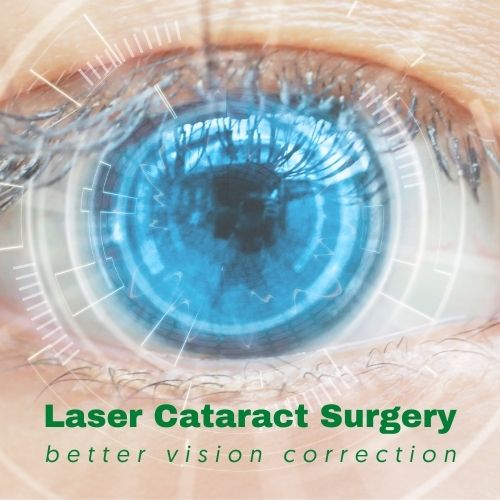What is Laser Cataract Surgery?


Laser cataract surgery improves the safety and visual outcomes of cataract surgery. The femtosecond laser can be used to improve the accuracy, precision, and safety of modern cataract surgery. When combined with traditional phacoemulsification, laser cataract surgery can yield the best surgical and visual outcomes.
Steps of Cataract Surgery
There are basic steps to modern cataract surgery;
- Corneal Incision
- Capsulorhexis, aka capsulotomy
- Removal of the Cataract
- Implantation of the Intraocular Lens
- Treat Astigmatism
The femtosecond laser can be used for many of these steps and to treat some patients with preoperative corneal astigmatism.
The Corneal Incision
The first step of any cataract surgery is to create an incision, or cut, through the cornea so that instruments can be used to enter the eye and remove the cataract.
Healing of the cornea after cataract surgery may lead to irregularities in the cornea called astigmatism. Just as many of us are born with a small amount of astigmatism, irregular healing of the corneal can create additional astigmatism.
One of the biggest advantages to the cataract laser is that it creates precise and accurate corneal incisions that heal properly that do NOT create additional astigmatism.
Capsulorhexis
This is perhaps the most crucial step in cataract surgery. The capsulotomy, or capsulorhexis, is the creation of a hole through the outer most layer of the natural lens. If the lens were an M and M, the capsulorhexis creates a hole in the outside candy shell to allow the lens material to be removed. In the M and M analogy, the lens material to be removed would be the milk chocolate.
The shape of the capsulorhexis is crucial. The best shape is to create a perfect circle. The precision of the laser makes this a routine and predictable part of the surgery.
Cataract Removal
Cataract removal typically uses a process called phacoemulsification to liquefy the cataract. By liquefying the cataract material, a smaller cataract incision is needed.
In the old days, the cataract was removed intact. This required a much larger corneal incision. Larger corneal incision lead to longer healing and astigmatism.
Removing the cataract removal is made easier by pretreating with the laser. Laser energy is used to soften the cataract allowing the phacoemulsification process to be performed much easier…and safer.
Intraocular Lens Implant
After the cataract is removed, an intraocular lens is inserted in place of the remove cataract. This is done manually and not requiring the laser. Intraocular lens implantation is covered in other articles. Standard lenses and premium IOLs can be inserted.
Correction of Astigmatism
Many patients have pre-operative astigmatism. Pre-operative astigmatism refers to irregular curvature of the cornea which blurs vision. This irregularity can be removed and smoothed out with use of the laser at the time of cataract surgery.
If you have astigmatism, speak with your cataract surgeon about this possibility. Not all degrees, or severity, of astigmatism either needs to be treated or can be treated.
If you would like to make an appointment, call us 609.877.2800 or EMail us.
Gregory Scimeca, M.D.
Ophthalmologist and Medical Director
The Eye Professionals
Our Locations
